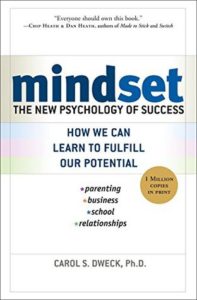I read Mindset by Carol Dweck early last year and the fact that the book remains fresh in my mind speaks to how much it impacted me. Mindset is based on a theory that Carol Dweck, a psychology professor at Stanford University has studied in over three decades of research.

Image Source: Goodreads
The concept of Mindset is one of those deceptively simple looking theories: Success in any field is driven by the trait of how you view your innate ability. A person with a fixed mindset considers their abilities and talents as being fixed at birth. On the other hand, a person with a growth mindset believes that they can continue to learn and grow themselves. Dweck’s research has consistently shown that adopting a growth mindset has a positive effect on how we view ourselves and consequently how we perform in various areas of our lives.
Take a look at the definition above, what do you think about it? Where do you see yourself? If you’re anything like me you saw yourself as a growth mindset person. Why would one be anything but growth mindset? It makes no sense.
But when you peel back the layers it’s not so easy. Turns out that being of a growth mindset requires courage and fortitude.
A person with a growth mindset:
– embraces challenges and new experiences
– soldiers on in the face of setbacks and obstacles
– understands that consistent effort is the only way to mastery
– recognizes the value in constructive feedback and even criticism
– learns from and is inspired by the success of others
A person with a fixed mindset:
– sticks to what they know best and stays away from challenges
– is easily frustrated by obstacles on the way to achieving goals
– believes that their innate ability is enough to make them successful
– takes feedback and criticism personally
– is threatened by the success of others
The book begins with a discussion of the mindset theory and what it means to be of a particular mindset. These chapters helped me appreciate how challenging it is to maintain a growth mindset in the face of difficult situations. As you can see above, one can claim to be of a particular mindset but see how they respond to criticism or their peer’s success and you truly understand their mindset. I also appreciate how the author has devoted an entire chapter to differentiating innate ability from accomplishment. Years ago, my cousin S pointed me to an interesting article about how girls are praised for their talents and boys are praised for effort and how that shapes confidence levels. I’ve since then noticed my tendency to ignore the important role of effort in my accomplishments. A good chunk of this book is devoted to examples of how mindsets play a critical role in the areas of sports, business, education, parenting and relationships. The book closes with a chapter on what it takes to change your mindset. A chapter that caused me to dive into my journal and reflect on my biggest accomplishments and setbacks.
As I feverishly scribbled into my journal, it was as clear as day that I’ve been of a fixed mindset for the most part of my life (with a bit of growth mindset to rescue me when I inevitably hit the wall). Despite my desire to learn and grow, I’ve let my beliefs about my innate abilities dictate my self-worth. Whether this was related to my education, career, relationships, creativity or just being a functioning adult with ADHD, this deep rooted idea has guided me astray often.
When I look back at every achievement that I am proud of, I cannot separate the role of diligent effort from my talents. It was gratifying and humbling for me to realize this. Let me give you an example from middle school, when I learned how to code:
When I first began to code at the age of 13, I found it incredibly frustrating and gave up on it because I couldn’t wrap my head around it. It didn’t help that I had some limiting beliefs about my ability to code because I was a girl. My cousin D, who was studying Computer Science at the time, offered to teach me. For what seemed like ages, she worked with me on a book of different algorithms, breaking down each problem visually and helping me write small pieces of code at a time. After working with her diligently, I went from almost flunking the class to getting the highest score in the class in the next test. I proudly remember the teacher praising me in front of the entire class for my improvement. This was growth mindset in action.
Of course, what predictably followed was a period of mostly fixed mindset where I began to believe that I was “good enough” at coding. I did the bare minimum needed to help me pass a test or deliver a project and not much more. Had I applied myself to it regularly I would have stood a chance at matching some of my more accomplished peers but I had long since believed the lie we’re all prone to believing about ourselves – “I’m good. I’m just not that good.” This is what fixed mindset can do to us. Make us believe that being really good at something isn’t accessible to us.
It’s important to remember, however, that this is a theory and not necessarily an explanation of every instance of success in the real world. There is no one explanation or theory or framework that fits every use case in this world. Also, while I support the role of the growth mindset in cultivating excellence, I am not sold on the notion that it necessarily predicts success. Success is a loose and subjective term that has many factors leading to it, dumb luck being one of them. When I read a book like this, I like to ask myself – Where does this idea fit into my life? If it does, I apply it. If it doesn’t I don’t try to force fit it.
Personally, I found that this book has helped me challenge the limiting beliefs that I had about my own abilities. It’s been illuminating to see my own experiences through this lens because it’s taught me that I can give myself permission to do something incrementally until I am good at it and beyond. And that there will always be someone better is a promising thought, not a reason to feel dejected.
One of my favorite quotes from Ira Glass about creative work does a perfect job of articulating this idea.
And finally, my favorite quotes from Mindset:
Becoming is better than being. The fixed mindset does not allow people the luxury of becoming. They have to already be.
The passion for stretching yourself and sticking to it, even (or especially) when it’s not going well, is the hallmark of the growth mindset. This is the mindset that allows people to thrive during some of the most challenging times in their lives.
When you enter a mindset, you enter a new world. In one world–the world of fixed traits–success is about proving you’re smart or talented. Validating yourself. In the other–the world of changing qualities–it’s about stretching yourself to learn something new. Developing yourself.
Many growth-minded people didn’t even plan to go to the top. They got there as a result of doing what they love. It’s ironic: The top is where the fixed-mindset people hunger to be, but it’s where many growth-minded people arrive as a by-product of their enthusiasm for what they do.
the best thing they can do is to teach their children to love challenges, be intrigued by mistakes, enjoy effort, and keep on learning.

Just recently I got this book as a gift and I have to admit that the idea of growth mindset is simple but very impactful. Loved the book, and your review on it is broken down and explained very well. Felt like you were sitting next to me and discussing about it very excitedly like good old college days. 🙂 Keep writing!
Thanks for the support Preethi! I wrote a ton when I was visiting my sister in Sydney. Hoping that bank of posts will help me maintain a weekly posting schedule. Fingers crossed. 🙂
So many new books to add to my list after being a part of ADHD Rewired. Thanks for the review. I feel very similar to you. I think I am just learning to recognize and embrace a growth mindset. I want to read this book now and grow in that even more!
I had that experience after doing the coaching group too 🙂 So many books! If you want to get an overall idea of the theory itself I believe you can easily read chapters 1,2,3 and 8. The rest of the chapters delve into different examples. When I finished the book I felt a bit exhausted from reading too many of the examples. Thanks for stopping by and commenting, Brandy!